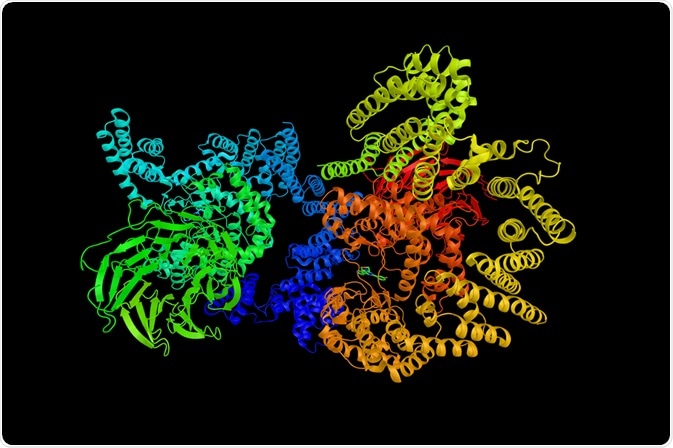All cells have many different ways of controlling their individual growth, depending on their proliferation within different environments or when different resources are available within these local environments. In mammalian cells, one of the most vital pathways for cellular growth and metabolism is the mTOR signaling pathway.
 Image Credits: ibreakstock / Shutterstock.com
Image Credits: ibreakstock / Shutterstock.com
The function of mTOR signaling
This pathway heavily promotes cell survival through the upregulation of protein and lipid synthesis, boosting cellular metabolism, and the downregulation of apoptotic pathways that would normally cause the cell to rupture.
There are 4 main functions of the mTOR signaling pathway: cell growth and proliferation, angiogenesis, bioenergetics through nutrient availability and boosting of metabolism, and cell survival through DNA repair and decreasing autophagy and apoptosis.
Mechanism of the mTOR signaling pathway
This pathway mainly uses growth factors as the initial signaling molecule required for activation. These growth factors bind to tyrosine kinase receptors in the cell membrane, which activates the pathway. Many of the enzymes involved in this pathway are activated by phosphorylation, when a phosphate group is transferred onto the target enzyme causing it to become active and continue the pathway to other targets.
After growth factors bind to the receptors on the membrane:
- The enzyme PI3 kinase is activated by phosphorylation
- PI3 kinase phosphorylates the substrate PIP2 into PIP3
- PIP3 activates the enzyme Akt, which then activates the protein mTOR
Then, mTOR activates many different transcription factors, which enter the nucleus of the cell and affect the transcription and expression of certain genes involved in cell growth and metabolism.
Types of mTOR
mTOR stands for mammalian/mechanistic target of rapamycin. Rapamycin is an immunosuppressant drug that was first isolated from a bacterium found on Easter Island in the mid-20th Century. One of the first effects that rapamycin was found to have was on TOR genes, which is where the name mTOR came from.
mTOR actually functions as part of a protein complex, where several different proteins that have different inhibitory and activatory effects are all bound together. There are two different mTOR complexes: mTORC1 and mTORC2. They have slightly different proteins involved in the complex, but they all stabilize mTOR and help it bind to its target receptor.
mTORC1 activates the ribosomal protein S6K, which upregulates protein synthesis. As well as this, mTORC1 inhibits the activity of 4EBP1, which normally inhibits protein synthesis. mTORC1 also encourages lipid synthesis, mitochondrial biogenesis, and downregulates autophagy.
Dysregulation of the mTOR signaling pathway
Due to mTOR having an active role in the activation of genes related to cell growth, any defects within mTOR function can lead to cancer development. For example, several genes activated by mTORC1 and mTORC2 can prevent apoptosis of cells and increase nutrient uptake, causing uncontrolled growth of cells and the formation of a tumor.
Hyperactivation of the mTOR pathway is also thought to be one of the leading causes of cardiac hypertrophy, which is one of the main risk factors involved in cardiac morbidity and cardiac-related mortality.
Aging is a complex process that has many factors at both the cellular level as well as within the human lifestyle, but the mTOR pathway has been shown to have a vital role within this process. The role of mTOR within cellular senescence and the immune response means that its regulation and maintenance is vital for health. Studies that aim to increase the lifespan of tissues have also been shown to involve mTOR signaling.
Sources
Inoki, K., et al. (2005). Dysregulation of the TSC-mTOR pathway in human disease. Nature genetics. https://doi.org/10.1038/ng1494
Laplante, M., & Sabatini, D. M. (2009). mTOR signaling at a glance. Journal of cell science. https://doi.org/10.1101/cshperspect.a011593
Li, J., et al. (2014). Rapamycin: one drug, many effects. Cell metabolism. https://doi.org/10.1016/j.cmet.2014.01.001
Papadopoli, D., et al. (2019). mTOR as a central regulator of lifespan and aging. F1000Research. https://doi.org/10.12688/f1000research.17196.1
Further Reading